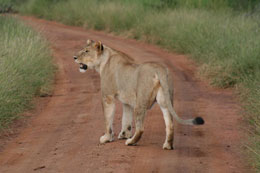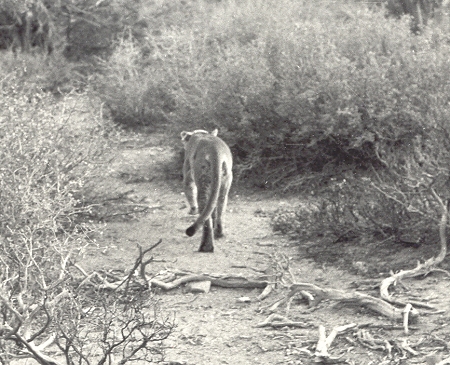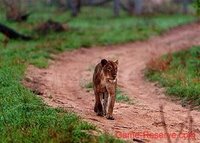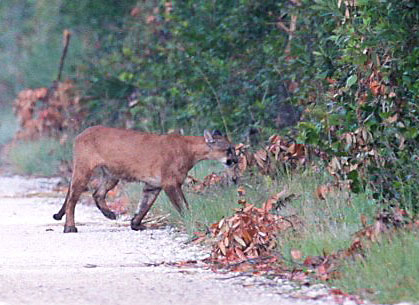
June 13, 2009
What is a “lion”? Is it an African lion? A maned lion? A female African lion? A mountain lion? A Detroit Lion? A Seibu Lion?

An African lion, female, directly above.

Lioness on a road, by Dick & Monique Smit, Henk & Liz Egbers, S.A.

An American panther, puma, cougar or mountain lion, gender unknown, directly above.

Lioness on the road at Uganda’s Queen Elizabeth National Park.

This cat is the “lion” of the Sunshine State, the “mountain lion” of the South, called a Florida panther.


Sometimes cryptozoologists need to be tested. Lion reports can throw a lot of things in the mix. Do not be distracted by foreground imagery, for in the background, as this visual analogy demonstrates, you might see the white-maned Seibu Lion or the blue Detroit Lion. All kinds of “quotes” from the authorities tend to deflect from the essence of the core reports.
Just look what’s going on with the sightings of North Georgia’s “lions”? What is happening down South, right now?
You do wish eyewitnesses and newspapers were a little more specific on what was being seen, sometimes. And officials gave more details. Sometimes they do, sometimes they do not.
Such an enigmatic situation has existed in northern Georgia, in the southeastern United States of America, for the past few weeks and days.
About three weeks ago, during the last week of May 2009, in the Lawton Drive area off Sardis Road, Gainesville, Georgia, two people claimed they were certain they spotted a “mountain lion” roaming undeveloped property near a tract of woods.
(Concurrently, a “brown lion” was being seen in Pleasant Grove, North Carolina on June 4, 2009.)
Then a “lion” was sighted on Georgia’s Highway 60 early Tuesday morning, June 9, 2009, near Gainesville, by a motorist.
Law enforcement authorities remarked to the media that if a “golden-brown lion” was strutting down the side of the road in the predawn hours near the Hall-Lumpkin county line, as a northbound driver reported to sheriff’s officials, it wasn’t native to this area. If it escaped from captivity, it wasn’t owned legally.
The report stirred sheriff’s officials in Hall and Lumpkin counties enough to conduct a search of the area with several deputies, and the owner of a nearby animal preserve was quickly contacted to make sure he had no escapees on the loose.
The Chestatee Wildlife Preserve, a facility off Ga. 115 that houses a number of exotic big cats, is about five miles from where the motorist said he saw the animal.
All the preserve’s animals, including two lions and five tigers, were accounted for, said Chestatee Wildlife Preserve owner C.W. Wathen.
Wathen said he went out with sheriff’s officials before dawn, armed with a tranquilizer gun, in case there was anything to the reported sighting.
“We didn’t see any signs” of a “lion,” Wathen said, but added that obvious indications such as paw prints aren’t always found. Wathen said the witness described the animal as being at least 6 feet in length. The animal “did not have a mane,” according to this one specific witness.
Hall County Sheriff’s Colonel Jeff Strickland said the witness was “adamant” that the creature he saw was a “lion.” (Thus, are we talking about an African lion? Or a mountain lion? It is never stated.) The man did not stop his car but called sheriff’s officials after reaching his destination shortly before 5 a.m., reported the Gainesville Times.
Hillary Hamilton of Murrayville, Georgia, told the Atlanta Journal-Constitution website that she saw the “big cat” near her house about 8:30 am, Wednesday, June 10, 2009, as she was leaving for work. Murrayville is in Hall County, about 10 miles southeast of Dahlonega, Georgia.
“I looked over there and I thought ‘what is that over there?’” she said.
Hamilton described it as “an animal the size of calf with a long tail on it, three to four feet long … and it was definitely a lion.”
The North Georgia woman said it was definitely not a coyote or fox. “No, no, no, no, no, no,” she said, “we have those in the area and I know what they look like.”
Hamilton said the animal “kept looking back at me and wagging its tail.” She said the animal walked into the woods toward a creek and she lost sight of it.
Sheriff’s office spokesman Jeff Strickland reported that deputies searched the area but found nothing. They also checked a game preserve about five miles from the scene but all the animals there were accounted for.
On Friday, June 12, 2009, authorities confirmed there had been another report from the Mount Vernon area.
“We have not found any kind of evidence at any of the locations where we’ve had the reports at,” said Department of Natural Resources Region Supervisor Ken Riddleberger.
Since people have been reporting they were “lions,” what does the state have to say about that?
“We don’t have any large cats that are native in the state of Georgia,” he said. Kenneth Riddleberger (whose name literally means “the handsome mountain dweller who solves mysteries”) told the media that if the animal is in fact a cat it is more than likely an escaped exotic cat or possibly an illegal exotic animal.
“We don’t believe we have any population of mountain lions or cougars in the state,” said Riddleberger.
The sightings, all between four and five miles apart, have all happened within the last week.
Perhaps there is a reason that the rather generic term “lion” is being used? Riddleberger said the descriptions of the animal vary, but the animal has always been described as a large cat.
There are no populations of mountain lions in Georgia, or for that matter anywhere in the Southeast, with the exception of Florida panthers, Riddleberger said.
Many times folks report things all the time, he said, and maybe they’re mistaking bobcats, large dogs or even house cats for lions, if they’re seeing them a distance.
“You never know what people might see,” Riddleberger said. “I wouldn’t discount it immediately. Some people may have certain animals in their possession, legally or illegally.”
“We know we don’t have any wild populations of large cats in Georgia,” Riddleberger said. “If there’s a large cat, it’s an escapee that someone has illegally.”
Back in September 2008, a large black panther weighing around 100 pounds was seen by a woman near a pond in Grovetown, Georgia, according to the Augusta Chronicle at the time. It stimulated a local biologist to make an interesting observation.
Vic VanSant, a biologist with Georgia’s Wildlife Resources Division mentioned they do get a number of phone calls from people that claim to have seen lions and large cats every year. He remarked that they even captured a mountain lion in 1995, inside the Clarks Hill Wildlife Management Area. It turned out it was a known animal that was part of an experiment with transplanted mountain lions in Florida. This particular animal made it’s way into Georgia. Intriguingly, it did not generate a single sighting report.

Your assistance is critically important in supporting the museum. Please…
Contributors of $60 or more received a personally autographed, inscribed copy of Tom Slick: True Life Encounters in Cryptozoology.
Thank You.
About Loren Coleman
Loren Coleman is one of the world’s leading cryptozoologists, some say “the” leading living cryptozoologist. Certainly, he is acknowledged as the current living American researcher and writer who has most popularized cryptozoology in the late 20th and early 21st centuries.
Starting his fieldwork and investigations in 1960, after traveling and trekking extensively in pursuit of cryptozoological mysteries, Coleman began writing to share his experiences in 1969. An honorary member of Ivan T. Sanderson’s Society for the Investigation of the Unexplained in the 1970s, Coleman has been bestowed with similar honorary memberships of the North Idaho College Cryptozoology Club in 1983, and in subsequent years, that of the British Columbia Scientific Cryptozoology Club, CryptoSafari International, and other international organizations. He was also a Life Member and Benefactor of the International Society of Cryptozoology (now-defunct).
Loren Coleman’s daily blog, as a member of the Cryptomundo Team, served as an ongoing avenue of communication for the ever-growing body of cryptozoo news from 2005 through 2013. He returned as an infrequent contributor beginning Halloween week of 2015.
Coleman is the founder in 2003, and current director of the International Cryptozoology Museum in Portland, Maine.
Filed under Alien Big Cats, Breaking News, Cryptomundo Exclusive, Cryptotourism, CryptoZoo News, Cryptozoologists, Eyewitness Accounts, Megafauna, Mystery Cats